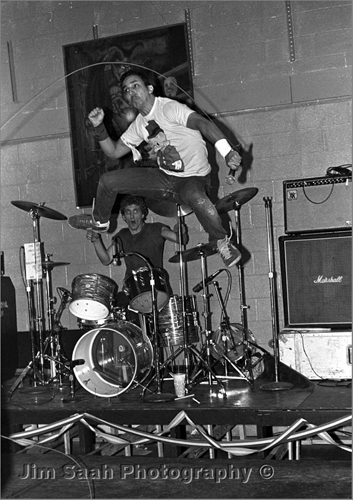I recently noticed a site where I used to freelance is having technical issues posting its archives. For that reason, I'm grabbing some of my pieces from that site and reposting here. First up, Rick Buckler from The Jam. Rick was about to embark on a February 2008 tour of the U.S. bringing From The Jam to Chicago. I also caught the show, which was great for what it was.
LiveDaily Interview: Rick Buckler of From the Jam
January 10, 2008 09:01 AM
By John Dugan
LiveDaily Contributor
In 1977, The Jam stood out from the rest of the punk explosion pack. The band had been honing its craft in pub gigs for several years and, while full of punk energy, the power trio also knew its '60s chops--mod rock, soul and even psychedelia crept into its compositions. The Jam also boasted Paul Weller, a songwriter with a class perspective.
The band only punctured the US charts a few times and, by 1982, the trio had split after releasing a No. 1 UK album, "The Gift." The group's rhythm section was particularly distinctive in its time--and now, it's back.
Following on successful tours of the UK last May and November, From the Jam -featuring original bassist Bruce Foxton and drummer Rick Buckler of England's mod-punk godfathers The Jam--will hit the States for 13 shows this month. Weller, who's issuing a deluxe, two-disc version of his second solo album, "Wildwood," this month, won't be joining them, however. Rather, Russell Hastings of Maximum High sings Weller's parts and plays guitar. To learn more, we spoke to Buckler as he enjoyed his teatime at home in the South of England.
LiveDaily: One thing that occurred to me is that From the Jam are touring as a four-piece, not a power trio. Is that because of keyboard needs?
Rick Buckler: Yeah, It was initially because of the keyboards. There are some songs like "A Town Called Malice" and "The Gift" that you really couldn't do without the keyboards, but Dave [Moore] is a good guitar player anyway, so it just gave us that chance to put in those guitar parts live that The Jam never did--that, obviously, we put onto record but never really played live. We had keyboard players and horn sections and backing vocals to augment the band, but we never had a second guitar. It's a nice little avenue to explore. It certainly adds to it; it's more like people remember from the record rather than necessarily the old live sound.
The overdubbed solos are there.
Yeah, all those nice little extra guitar things that are on the record.
So Russell and Dave are both playing guitar?
Russ is the main guitar, if you like, and Dave flits between keyboards and guitar.
As for Russell's voice, does he turn extra Wellerisms on, is it his own singing style, or in between?
It's entirely his own thing. He sings in the way that he sings. He doesn't come from a million miles away from Paul or from us, in the south of England. He's his own man and does his own thing. I don't think he regards it as filling anybody's shoes. I don't know if you know, but, years ago, he was a big Jam fan himself. He had been to several of the shows, [including] the last one. I only bumped into him a few years ago. I knew what he had been doing. I had been running a website, the Jamfan.net, and each year I used to put on a show in the Woking/Guilford area and hire a few bands in. And one of the bands I got in was Maximum High, which Russ was in.
I was always quite impressed with his stagecraft. I think he really fit in. When we first got together with him to put The Gift [an earlier band that covered Jam material] together, it all fell in really nicely. He had the passion for the songs and understood what was needed from the songs.
How did The Gift and Bruce Foxton get together?
Bruce was doing Stiff Little Fingers and was also in another band called Casbah Club. We ended up being on the same bill at Guilford. I called him up and [asked] him did he fancy jumping up and doing a couple of numbers with us. We did "Smithers-Jones" and "Tube Station," I think. The reaction was fantastic. He did one or two more guestings with us. By the end of 2006, we decided to make the whole thing concrete and do the thing properly. We ended up with a May tour of the UK, and went on to the bigger tour that we've just finished in November and December. I think Bruce discovered, as I did, that it was great fun to revisit the Jam material, and that the original Jam fans, as well as new ones, were out there and wanted to hear it. Everybody was a winner.
The music seems so relevant and so many bands draw on The Jam. Everything has come back around in a lot of ways.
I think that is all due to Paul's songwriting. A lot of the songs have lasted the test of time. In some cases, it's unfortunate that they still have meaning with "Little Boy Soliders" and what have you. The world doesn't seem to have changed that much. Paul was always very good at observing things and translating them into verse, at it were. That is obviously what has lasted.
Being a drummer myself, I know that some songs come back to one easily, and others are a bit harder to remember how to play. Which Jam songs were the trickiest for you? "Tube Station" is a bit of a workout on the hi-hat, right? Were there any you had to work at?
I hadn't played for 12 years [before The Gift]. I was literally at the starting point again. I just put in loads and loads of practice. It's not too bad; I'm lucky enough that if there are things that I can't remember, I just pull the album out and listen to it, and refresh my memory on certain bits. It did take me a while to get back up to speed. It all seemed worthwhile, and we had a lot of fun doing it. It's not that difficult. It's like riding a bike, but knowing that you are going to take part in a race, not just go down the shops.
People are going to be watching.
I did find that a bit of a shock--people were watching more intently than I thought they might do. I really thought that I better shine up my shoes and everything.
Last year you celebrated the 30th anniversary of the release of "In the City," The Jam's 1977 debut. Why is "In the City" still a classic? I always think of that being the pubby, punky side of The Jam. How do you feel about that record?
That was the culmination of what we had been rehearsing for, for the first five years. It was the best of what we could put together to do that first album. There wasn't a lot of songwriting involved. It was already there; we just had to record it. In that way, it was fantastic and it was done live in the studio as well. ... It was a learning curve with us. With [1977 follow-up album "This is the Modern World"], we tended to be a bit more delicate in the way we did things without trying and testing the songs. To come up with an album before you take it out to the crowd was a weird thing for us. People didn't know the material. The whole thing was a very long learning curve. By the time we got to [1978's] "All Mod Cons," I think we'd got it together about the way that we did things. Each album was a turning point for us, a musical idea or just in the way we worked. The whole thing of, "This isn't a hobby anymore chaps; you really have to get this together," dawned on us quite early in '77, because we did two albums in '77, you see.
There is that Beatle-y evolution with The Jam, "We're gonna outdo what we did on the last record." That's the mark of an ambitious band, trying to one up yourself.
It was always a bit strange for us; we never really felt like we had a groove like some bands have. You see bands that, once they find a particular thing that works, they stick with it and ended up sounding samey. We never saw ourselves in any particular slot, we managed to stay out of the rut by simply dodging it all the time. I think that's what kept us alive musically: that we could continually experiment. Maybe that's why Paul, in the end, found that he had nowhere else to go with it. I don't necessarily agree with that view, but some of the things he said near the end, he wanted to move on. I thought The Jam was very much moving on anyway.
It seems a bit odd, considering that Weller played some Jam tunes the last time I saw him in Chicago--in 2004 I think it was--that getting back together wasn't a possibility for him. Was there any discussion?
He's pretty much drawn the line and said he's not into any sort of band reunion and made all sorts of comments about how destitute he would have to be [laughing] and all sorts of things. So there didn't seem to be a lot of point, but, on the other hand, we did make it known that, in the early stages, that the door was open to him anytime and still is, if he wanted to come along and have a bit of fun. But we didn't want to get tied up in the perception that if Paul wasn't involved then it couldn't happen. Because, as far as myself and Bruce are concerned, that's not the way things were. We were two-thirds of the band, and we probably have every right to go out and play these songs, as much as Paul has. Our only concern was, how would the fans take to that sort of scenario? And we've found that they've been very happy with it. Most Jam fans have been waiting for this for a very long time. I think they are a little let down that Paul won't get involved, but I think that's Paul letting himself down. I really don't know what Paul thinks about this because he's very difficult to talk to and we haven't--at least I haven't--spoken to him in a long time. He has got his own career and his own thing happening, and maybe that's where he wants to focus himself. And if he doesn't want to get involved, fair enough. It should never really stop me and Bruce from doing what we want to do.
If you have a proper balance of doing it for the love of the music and for the fans, people seem accepting. I don't get the sense that you are just doing it to make money.
In reality, we are obviously doing it to earn some money. We couldn't do it if we weren't earning money. But the only reason we are able to earn money is that we have people who want to come and see the show. It all sort of follows, so I don't feel guilt for being paid for the job I do. We are having a great time doing it.


